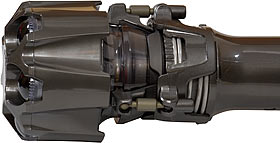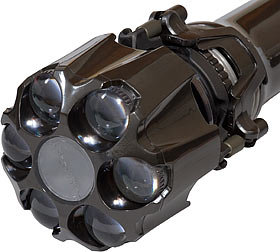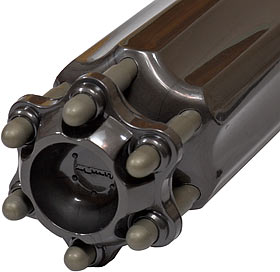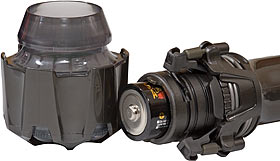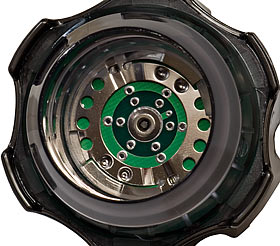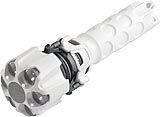
LumaRay FL6 LED flashlight
Review date: 14 July 2005. Last modified 03-Dec-2011.
When people ask me what sort of Web site I run, I tell them that I review computer gear, and toys, and gadgets.
(They then usually tell me that they do tech support, or carry sulfur down from Indonesian volcanoes, or chip portholes in battleship hulls with a rapid succession of cold chisels.)
The word "gadget", however, means different things to different people.
To many people, "gadgets" are the miserable excrescences that people buy when they're tired and emotional, or because they need a present for their dad and are completely out of ideas. Electronics stores sell cheap examples of this benighted breed; vendors like The Sharper Image and its UK/Aussie relative Innovations (with or without their Catalogue) sell the definitive examples.
If you actually want yet another take on the idea of a screwdriver with a flashlight attached, or a radio with, um, a flashlight attached, or an air purifier for your car with a fold-out, ah, screwdriver - then these are the retailers for you.
If you for some reason would rather buy a solid product that does something useful, though, "gadget" shops and their similarly disreputable relatives, "gift" shops, are not the place to go.
Shop somewhere better, and you can find quality gadgets. A quality gadget is something technically innovative (or that was technically innovative when it was invented) that serves its purpose well. It doesn't need to be anything useful - a Böhm Stirling engine, Kyosho MP777 or Lego logic gate doesn't do anything very practical - but it has to do what it's meant to do in a reasonably competent fashion.
Maybe that definition doesn't quite cover it. It's better to say that good gadgets are just pleasing things. Items that're pleasant just to handle and look at, even when they're not doing whatever it is that they're made to do.
OK, maybe you're pleased by the inflatable solar powered pikelet sugarer with rotary Pavlova strawberry spreader you bought from some spiritual offshoot of The Franklin Mint. Great. Fine.
But you're wrong. I'm right. Deal with it.
Purity. Functionality. Elegance.
The Victorinox SwissFlame, perhaps; the old Leatherman Micra, definitely. The Glo-Toob, perhaps; the Photon Micro-Light, definitely.
After a while, the difference between good and crappy gadgets becomes easy to spot. Many crappy gadgets, in particular, are all style and no substance.
I am, therefore, duty-bound to say that when I first clapped eyes on the LumaRay FL6 LED flashlight, I was profoundly suspicious.
People who see this thing can't resist mentioning that it looks like a sci-fi prop. Because it does. It really does. It's practically got greebles.
And this was why I was suspicious. Because sci-fi-looking stuff, generally speaking, doesn't work.
When the first consideration is how cool something looks and not whether it could actually be made to function within the confines of our universe's laws of physics, you get things like combat mecha. 'Mechs are cool beyond all description but, assuming technology to allow them to leap around like giant acrobats and not just skate around shakily existed, they'd very probably meet a dreadful fate at the hands of ordinary wheeled, tracked and winged machinery using that same technology in a less groovy way.
And electrically, the FL6 is nothing special at all. Three C cells feed six white LEDs, without any fancy electronic regulation or flasher modes or multiple beam colours. You twist the end to turn it on and off, as with many other simple LED lights.
This makes the thing look, at first glance, like the flashlight equivalent of movie vehicles that're just some ordinary real-world car, bike or helicopter crusted up with fibreglass.
Optically, the FL6 is also not amazing, though it is a bit different. Its LEDs lurk behind six sizeable plastic lenses, which give the flashlight a quite smooth, tight beam (nice and white in the middle, rather blue around the edges) about 15 degrees across, with little side spill.
This beam size is a compromise between throw range and close-up utility - more of the former, less of the latter. Most LED flashlights have a very wide beam that's great for seeing where you're going but no good for distant work; many cheap incandescent-bulb flashlights have a narrow beam that's adequate for spotting possums but unhelpful on the way to the bathroom at 0100 hours. The FL6 is usable indoors, and handy outdoors.
At one metre, the FL6's peak fresh-battery brightness is about 430 lux. Small 1W Luxeon Star lights like the Longbow Micra can match or exceed this brightness - the Micra manages about 600 lux. Really bright 3W-Luxeon lights like the Elektro Lumens FT-3C can get way up into the thousands of lux. But a six-plain-LED flashlight wouldn't normally come anywhere near managing 400-odd lux at one metre; the FL6 does it because of its narrow beam.
Only six LEDs means pretty low current draw, though, so the FL6 gets excellent battery life. LumaRay claim 10 to 15 hours of high brightness from one set of three C alkalines, which is perfectly plausible. After that, you'll get at least a few hundred more hours of usable light; LED flashlights are very good at making use of near-dead batteries to deliver better-than-nothing light, which along with the unbreakable nature of LED lamps makes these flashlights great for emergency use, spelunking, and the miserly.
LumaRay make an FL12, as well; I review it here. It's an FL6 with an extra six normal-lensed LEDs in the middle of the lamp assembly. Those LEDs greatly brighten the beam, and ought to roughly halve the total run time - but don't, as I explain in the review.
The flutes on the side of the FL6's head are meant to stop it from rolling, but they're not big enough to do the job on anything beyond a very gentle slope.
More inventively, there's a luminous coating around the LEDs inside the head, so when you turn the FL6 off, the LED lenses continue to glow a faint green, so you can find the light in the dark. If your eyes are adapted to the dark, and you've used the light for a while (or just put it somewhere well-lit), the luminous coating will glow visibly for several hours. It doesn't charge up instantly, though; turn the light on briefly and the glow coating won't get a whole lot brighter.
The tail end of the FL6 is somewhat reminiscent of the tusks on the bottom of Darth Vader's mask. It's quite practical, though; the tusks give you a choice of six holes to loop a lanyard through, and also allow the light to stand on its tail and illuminate the ceiling, which is a good way to light a room with a flashlight.
To remove the FL6 lamp, you turn the complicated-looking assembly behind the lamp to unlock it, and then you pull that assembly back. It's a mildly mystifying procedure the first time you do it, but easy enough after that, and not terribly difficult to do if your hands are wet and/or gloved.
Pulling the assembly back causes three catches to swing out from a flange around the bottom of the lamp assembly. The pressure of the spring-loaded batteries inside then pushes the lamp up so the claws can't re-engage.
Inside the lamp, there's a shiny contact ring - you can also see the unoccupied mounting points for the six plain LEDs of the FL12 variant.
This whole arrangement may seem ludicrously overcomplicated compared with the common screw-switch design of many LED flashlights - tighten the lamp down to turn the light on, loosen the lamp right off to remove it. But there's actually some sense to it. The FL6 lamp-switch can only turn a limited amount, so you rub the water-seal O-rings less when you use it. And there aren't any threads at all to wear out, or collect dirt.
Then again, screw-end lights can be really, really waterproof. The old Tektites I review here are true dive lights, rated for a monstrous thousand-foot submersion. The FL6, in contrast, is only waterproof to 15 feet.
It's built solidly, though. The body's made from polycarbonate and the proprietary PBT/polycarbonate blend called "Xenoy", and the spring at the base of the lamp retainer is stainless steel.
There's an extra O-ring on top of the two that actually keep water out of the light; the third one's strung across three slots in the body of the light, so it crosses the edge of the battery compartment and stops the C-cells falling out when the lamp's removed.
Well, it kind of does. The first battery can pretty much drop out unimpeded; the other two just can't follow it. If you try to shake them out, it's surprisingly difficult - if you just hold the FL6 body upside down and jiggle it a bit, though, they work their way past the O-ring quite easily.
If you sit there taking the lamp off and putting it back on again over and over, as I've just done, you'll end up with at least one sore thumb. The crenellations on the back of the lamp aren't the most perfectly ergonomic things ever created, either; if you have to hold the FL6 up around the lamp for some reason, all of the techno-bits at that end make it quite uncomfortable. In normal use, though, the FL6 feels good; the switch is smooth (smoother than pretty much any screw-end light), and the twiddly bits at each end mean the smooth body of the light isn't likely to slide out of your hand, even if it's wet and greasy.
Buying one
LumaRay sell their lights directly. The FL6 is $US69.95 plus shipping; the FL12's $US119.95 plus shipping.
Overall
Appearances can be deceptive. Yes, the LumaRay lights look outrageous, but they're well made, and they work.
The FL12 price would be too much to pay if it were just the same light with six more LEDs, but happily, it isn't. It turns out to offer about the same value for money as the FL6, if you ask me.
The FL6 is definitely well priced. It's certainly not the brightest 3-C-cell light out there, but it's bright enough for most purposes, and gets great battery life.
There's not much reason to buy an FL6 if you don't want a narrow beam, or if you just think it's ugly as sin. Personally, I'm ambivalent about the look of the FL6; I'm not repelled by it, but neither do I especially want to show it off to visitors. Your opinion may vary.
If you want a broader beam from a flashlight that looks more like a flashlight, there are plenty of options. The old Lightwave 3000, for instance, is still out there for $US50, and zillions of Chinese knockoff LED lights, often of passable quality, are now available on eBay for rock bottom prices.
If you think the FL6 looks cool, though, be advised that it is not some stupid piece of fragile plastic that doesn't bloody work. It's real, it's tough, and people who love its look will not be disappointed by the rest of the package.
Review FL6 kindly provided by LumaRay.
New version
I review the updated "2006" version of the FL6 here.
Big brother
I review the LumaRay FL12 here.

